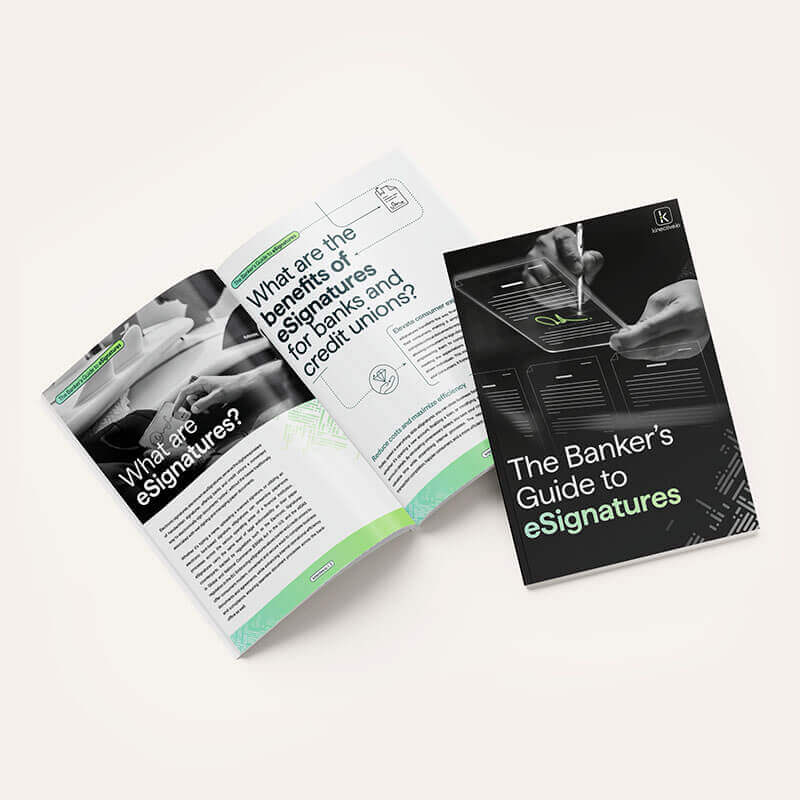This article was originally published in The Financial Brand
Banking is commonly chided for its risk aversion. But when it comes to signatures, with all the protections they provide when fixed to the right documents, can the industry be too risk averse? Here’s how two institutions addressed those risks, charting a path to one of banking’s most elusive experience upgrades.
Electronic signature (e-signature) sounds like a simple enough proposition: Provide people a tool to sign digitally, kiss wet signatures goodbye, and say hello to banking with anyone and anywhere. It’s a great vision, so why are banks and credit unions still developing their use of a technology brought to market just after the turn of the century?
When you look at the industry as a whole – across asset size and charter type – less than 60% have any technology for remote signing, according to data provided The Financial Brand by FI Navigator. While larger banks have a higher likelihood to own signing software, for an innovation from the days of compact disks that’s pretty low adoption.
Signature protects institutions from a host of risks: relationship, compliance, legal, and credit-related. They are the backbone of banking without which institutions cannot originate products, nor can consumers or businesses use them. They are the period required for a complete banking sentence. They are the final stop, aside from funding the loan, on the road to asset growth.
It begs the question: Can the industry be too risk averse about a legally-binding step that protects them from so much risk?
Some of the problems lie in the fact that they can buy the technology, but it may not be built to work well in banking. If it’s not adopted by staff and account holders to close loans, open new accounts, or provide a great servicing experience, then the investment isn’t worth it. Using that measuring stick, the industry likely have less than 60% adoption if the metric were adopted by staff and account holders.
In that case, those who bank with about half the industry still see signature processes that crawl at the speed of pen and paper.
A Case Study for Successful E-Signatures: Fine Tuning All the Little Things
Before 2000, the year Congress implemented the ESIGN Act, the physical signature was banking’s bottleneck. Once the act was passed, financial institutions could use knowledge-based authentication and a one-time password to validate signers and gather signatures. Only a few industries, like pharmaceuticals and healthcare, now use the more secure “digital signature” which requires a physical key to authenticate a signer.
It was a great step in the right direction for the banking industry. Since then, however, nothing has changed more than how we interact with the written word.
Simply buying an e-sign software (adding the extra cost of technology) leaves that bottleneck intact.
On the other hand, the tech investment if executed correctly has a sizable payoff. Banks report the benefits of adopting e-signatures to show up in annual interest income, loan quality, the efficiency ratio, and even new product offerings.
The case studies for the best e-signature banking strategies are those using it with account holders who hail from all over the world, such as AMOCO Federal Credit Union. Based in Houston, the credit union has a membership of 103,000, who work in the oil and energy industry and often relocate globally.
“Our members work and live in Europe or Asia, you name it,” Nathan Ashworth, who led AMOCO Federal Credit Union’s launch of e-signature in 2009, tells The Financial Brand. “We needed to make it easier for them to complete loan or maintenance documents, or to open membership remotely. It’s great if you have the technology to start the process, but if you have to mail the documentation in the end, it negates the whole experience.”
Even small breaks in the experience are big problems for remote signature, Ashworth says. “A really important piece of the puzzle is a device-agnostic experience.” The first remote signature company they worked with had little to no congruity between different kinds of devices. “It’s just too difficult to service the variants of devices when you’re not sitting there with a member. That does not meet the consumer expectation.”
Device idiosyncrasies completely derail adoption, Ashworth says. “If members try to open up the documents and struggle to sign them, they will give up,” he says. “The consumer expectation is set by Amazon. Once they kick the process off, people expect us to capture all authorizations from them in that one fell swoop in a way that’s really easy to digest and execute.”
Staff are the same way, Michael Ball, EVP of direct sales at Kinective (a purpose-built e-signature provider for banking), tells The Financial Brand. “When employees hit an unknown, and it’s not easy to figure out, they just don’t use it,” he said.
These friction points can be as simple as an employee adding multiple signors to a loan document. If they don’t understand the digital process, they’ll resort to the old methods, Ball explains. “Now you’ve invested in a platform for a banking experience upgrade that’s not used at all.”
Given today’s rate environment, financial institutions are now upgrading to e-signature for account opening, just as much as lending, Ball says. “They want to make onboarding quick and easy for a new customer. It creates a great first impression about the financial institution.”
Click here to read the full article at The Financial Brand.
Article updated August 2024

